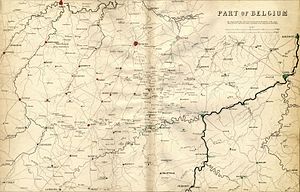| Waterloo campaign: start of hostilities (15 June) | |||||||
|---|---|---|---|---|---|---|---|
| Part of the Waterloo campaign | |||||||
 A portion of Belgium with some places marked in colour to indicate the initial deployments of the armies just before the commencement of hostilities on 15 June 1815: red Anglo-allied, green Prussian, blue French | |||||||
| |||||||
| Belligerents | |||||||
|
|
| ||||||
| Commanders and leaders | |||||||
| Napoleon | General Graf von Zieten | ||||||
| Strength | |||||||
| Army of the North | I Corps | ||||||
| Casualties and losses | |||||||
| 252[1]–400[2][a] | 1,200[3]-2,000[1] | ||||||
The Waterloo campaign commenced with a pre-emptive attack by the French Army of the North under the command of Napoleon Bonaparte. The first elements of the Army of the North moved from their peacetime depots on 8 June to their rendezvous point just on the French side of the Franco-Belgian border. They launched a pre-emptive attack on the two Coalition armies that were cantoned in Belgium—the Anglo-allied army under the command of the Duke of Wellington, and a Prussian army under the command of Prince Blücher.
Hostilities commenced shortly after the French advanced guard crossed the border and encountered the first Coalition outposts manned by soldiers of the Prussian I Corps (Zieten's) around 03:30 on 15 June. For the rest of the day the I Corps engaged in a fighting retreat against the overwhelming force of the French Army of the North. By midnight of 15/16 June the French had advanced north and through Charleroi and in doing so successfully crossed the river Sambre, the only significant river between the French army and Brussels.
At 19:00 on 15 June Marshal Ney, who had ridden up from Paris, met Napoleon near Charleroi, at the point where the road to Fleurus branches off from the one to Brussels. He was ordered to take command of the left wing of the Army of the North and press north up the Charleroi–Brussels road towards the Anglo-allied army and "drive back the enemy"[4] while Napoleon would advance up the Fleurus road and do the same to the Prussians. The advance up the two roads continued until darkness, but slowed during the evening as Coalition troops fell back on reinforcements. The French planned to renew their advance on 16 June, while the Anglo-allied army planned to check them at Quatre Bras, and the Prussian army at Ligny.
- ^ a b Hussey 2017, p. 362.
- ^ Wit 2009, p. 1.
- ^ Siborne 1848, p. 111.
- ^ Siborne 1848, p. 114.
Cite error: There are <ref group=lower-alpha> tags or {{efn}} templates on this page, but the references will not show without a {{reflist|group=lower-alpha}} template or {{notelist}} template (see the help page).
